About Civil War Bluejackets:
The Civil War Bluejackets Project is transcribing ship muster rolls from the 1861-65 U.S. Navy, uncovering the stories of the c. 118,000 common sailors who fought for the Union during the American Civil War. Over 30 percent of these men were working-class emigrants from Britain and Ireland, while another 15 percent were African American, many of whom had escaped enslavement to enlist. The musters we are working on were taken every three-months aboard all U.S. vessels. They record highly detailed information about each sailor, including their name, age, place of birth and even their previous employment. Some of them can capture incredible detail about individual sailors—such as the tattoos they inked on their skin, or the scars that marked their bodies.
Using our volunteer transcriptions, The Civil War Bluejackets Project—named for the distinctive shell-jacket these sailors wore—aims to create a unique database for historians and genealogists alike, which as well as recording men’s muster information will link their entries to other digitised material on Civil War sailors, such as their enlistment details and pension records.
The Civil War Bluejackets transcription project began on Zooniverse in September 2022, and to date has seen over 600 volunteers engage with transcribing these sailor’s details. The transcriptions form part of a wider Arts and Humanities Research Council UK funded project being carried out by historians at Northumbria University and Information Scientists at the University of Sheffield and University of Koblenz-Landau. As well as creating a “one stop shop” database for anyone interested in exploring these men, the team hope to use the data our transcribers create to develop new computer software that will help with the interpretation and analysis of 19th century handwritten documents. The efforts of our volunteers will also lead to the production of a new history of ordinary sailors during the American Civil War, with a cornerstone of the project being the constant sharing and public dissemination of new discoveries as they are made.
The work of our transcribers is already producing invaluable information about both ship crews and the individual sailors themselves. We are beginning to be able to reconstruct the ethnic and racial mix that was present on different ships at different times during the war—factors that could play an important role in how men experienced life within their “shipboard community”. Take for example the USS Carondelet, which was one of the best-known Union ironclads of the Civil War. Carondelet spent most of her war on the Mississippi River and its tributaries, fighting in some of the most famous naval engagements of the whole conflict. By looking at her muster rolls, we can see how the makeup of her crew changed during the war, and consider what that might have meant for those aboard. We now know that in the early part of her service, Carondelet did not have large numbers of European immigrants on her crew, but this gradually changed as the war went on. By April 1865 you could hardly move for them—at that date more than 30 percent of Carondelet’s sailors had been born in England, Ireland, Scotland or Wales.
Beyond the crews, the work of our volunteers is also telling us a huge amount about the sailors, their backgrounds, and their families. One of them was English emigrant George Chapman, who served on USS Tecumseh. George was a 40-year-old Machinist living in New York when he enlisted in February 1864. 1860s life was tough for George and his family. We know that his 14-year-old son was already working, employed as “Soap Boiler.” The hazards of working-class life had also left their mark, as the Navy recorded that George had a scar under his right eye and on his forehead. George’s naval records also tell us that he was living in Scotland just prior to the Civil War, as the pension file associated with him notes he had married his wife Alice in Edinburgh in 1857. By the time George enlisted in 1864, Alice was around six weeks pregnant. Neither she or the children ever saw him again—George perished when the USS Tecumseh and most of her crew went to the bottom during the Battle of Mobile Bay, Alabama on 5 August 1864.
The extraordinary detail in the naval records allows us to reconstruct in often minute detail the lives of sailors and their families—men you will help us to discover on Transcription Tuesday. You can get a flavour of some more of these stories on our blog (you can read George’s story in more detail here).
How to take part in Civil War Bluejackets:
Step 1
We hope you will consider “climbing aboard” with us for Transcription Tuesday! To join us, go to our Civil War Bluejackets Zooniverse Page.
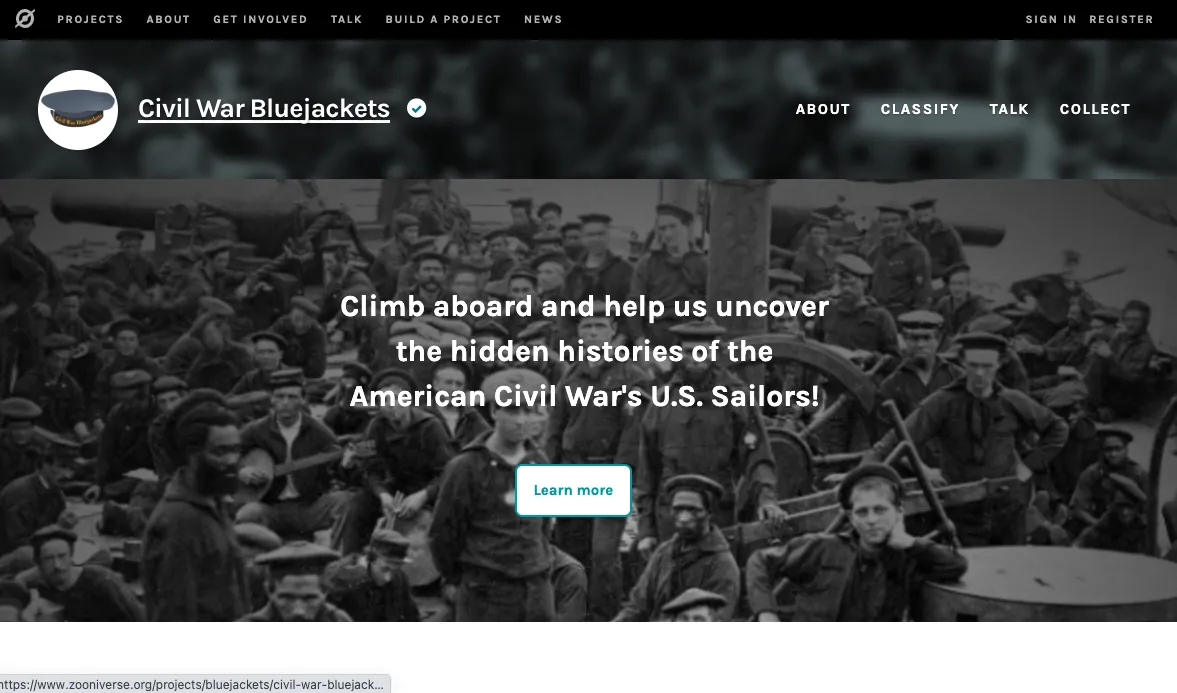
Step 2
Scroll down to 'Get Started'. You will see a choice of eleven 'work flows'. You can click on any one of them. In this example, we're choosing 'Names'.
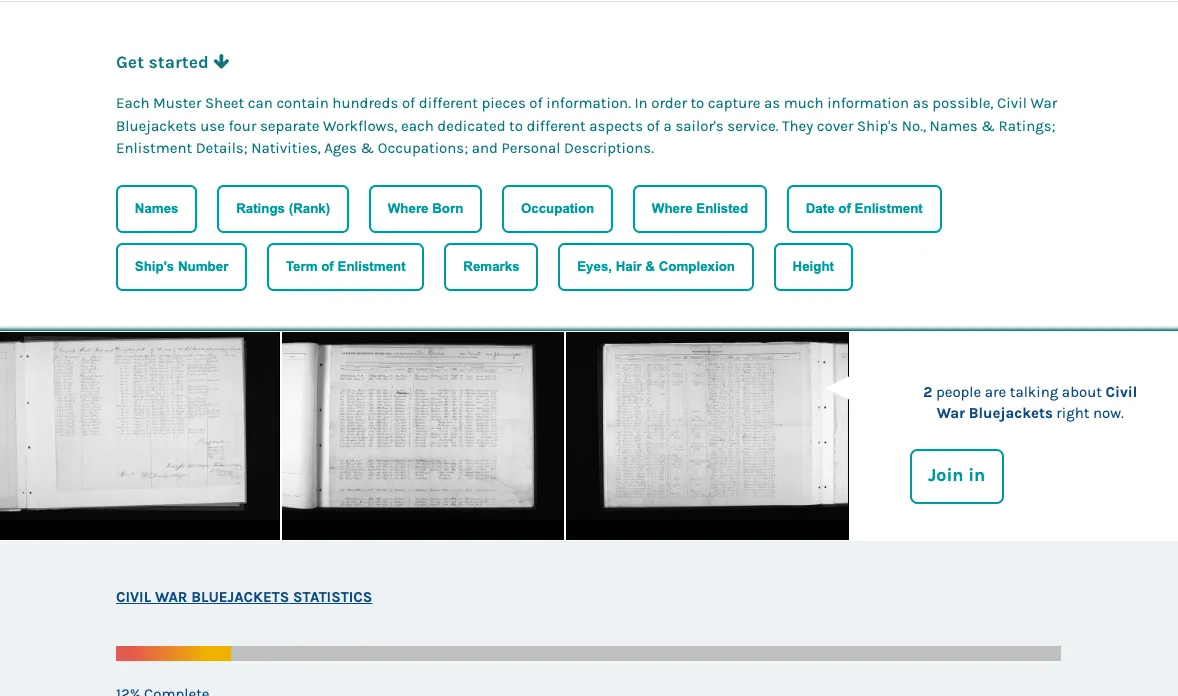
Step 3
A window will appear with a tutorial that you can read if you want extra instructions.
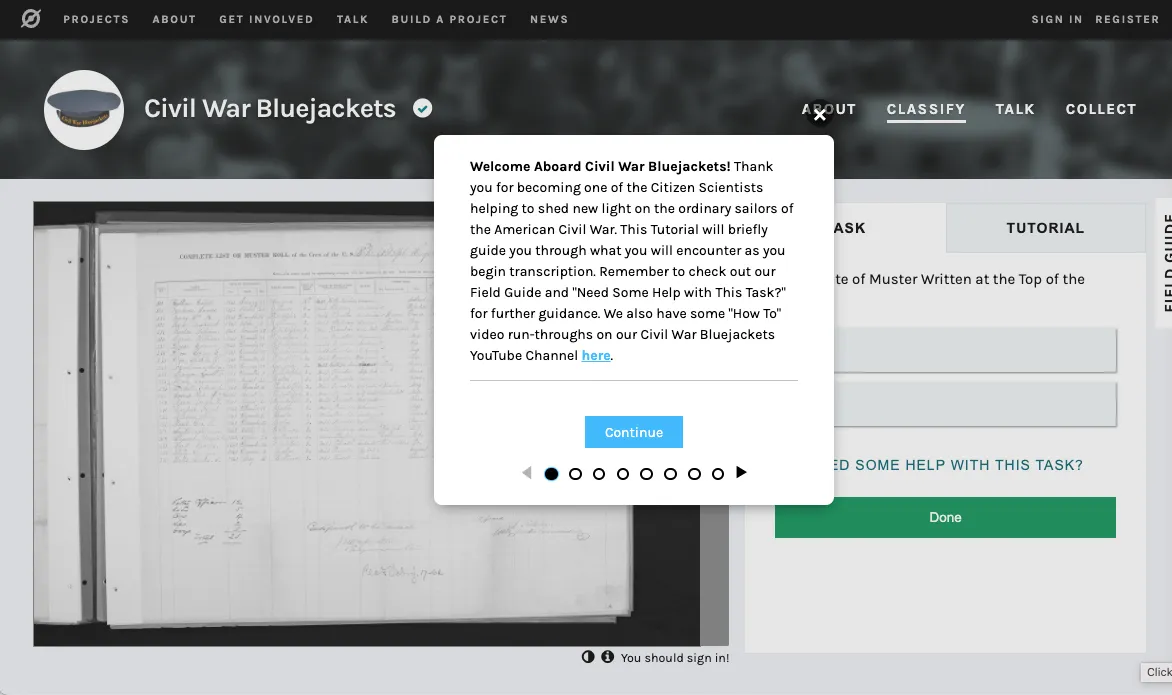
Step 4
You will be asked 'Is the Date of Muster Written at the Top of the Sheet?' Click 'Yes' or 'No'. In this example, we're clicking 'Yes'.

Step 5
Enter the Date of Muster precisely as written. In this example, it's 'First day of January, 1864'.
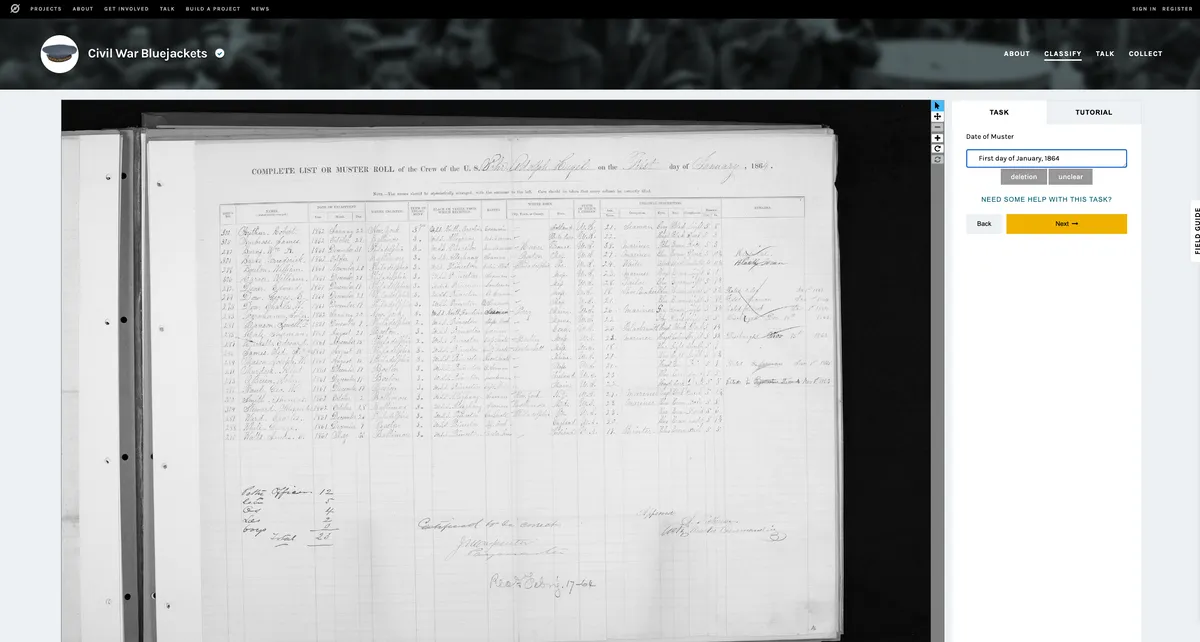
Step 6
Click and drag on the picture of the record to draw a box around each entry in the 'work flow' (in this case the names column). Then transcribe the information in the box. Click the yellow box that says 'OK' when you've finished. Remember you can use the Navigation tool (the cross-like symbol that's second from the top in the row of symbols between the record and the list of instructions) to move the page around, and the plus and minus symbols below that to zoom in and out.
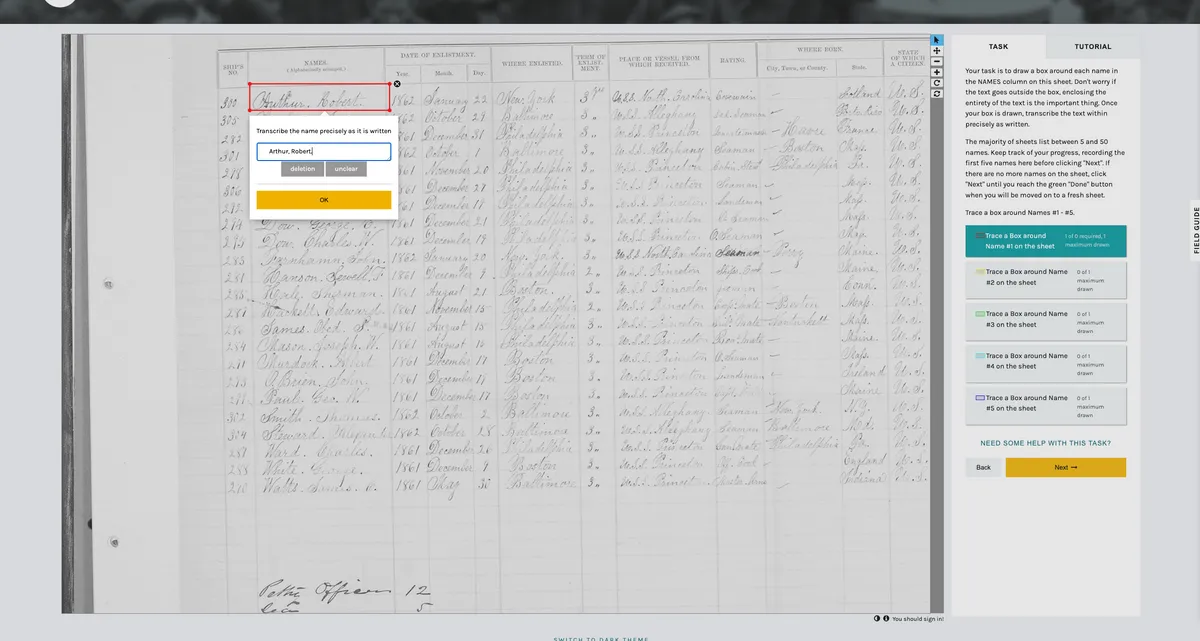
Step 7
Click the next box on the right (in this example, 'Trace a Box around Name #2 on the sheet'). Then draw a box around the next row and transcribe it. When you have finished, click the yellow 'OK' button.
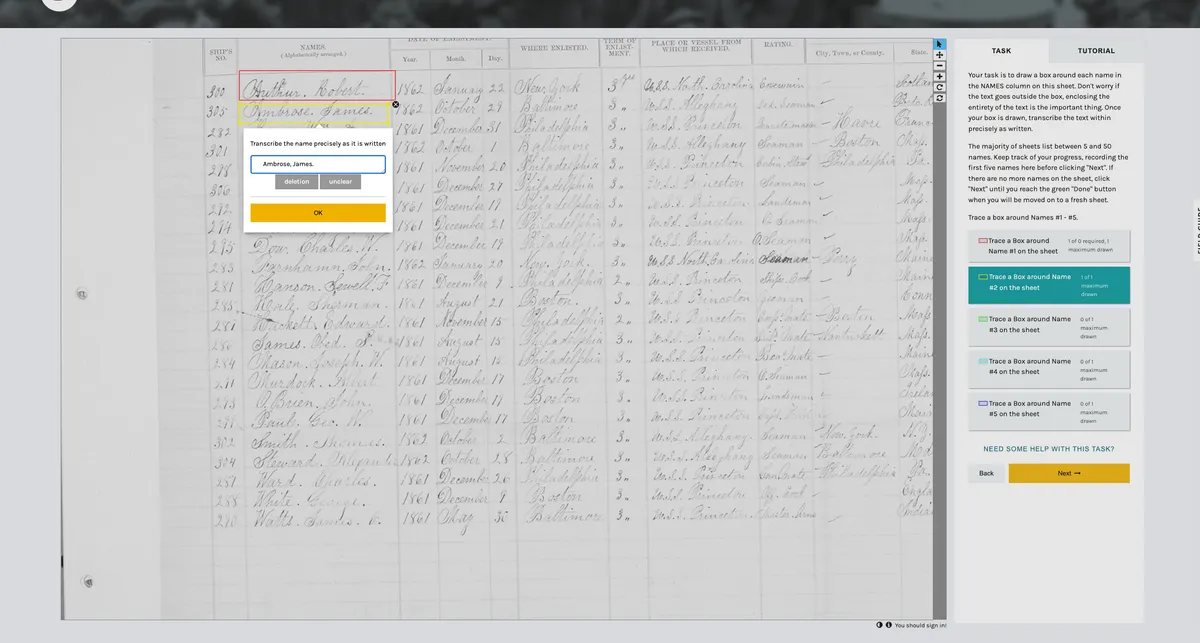
Step 8
Continue to transcribe the rest of the data on the sheet. If you make a mistake, you can click on the 'Back' button to correct it. When you have worked down a list of five rows, click the yellow 'Next' button.
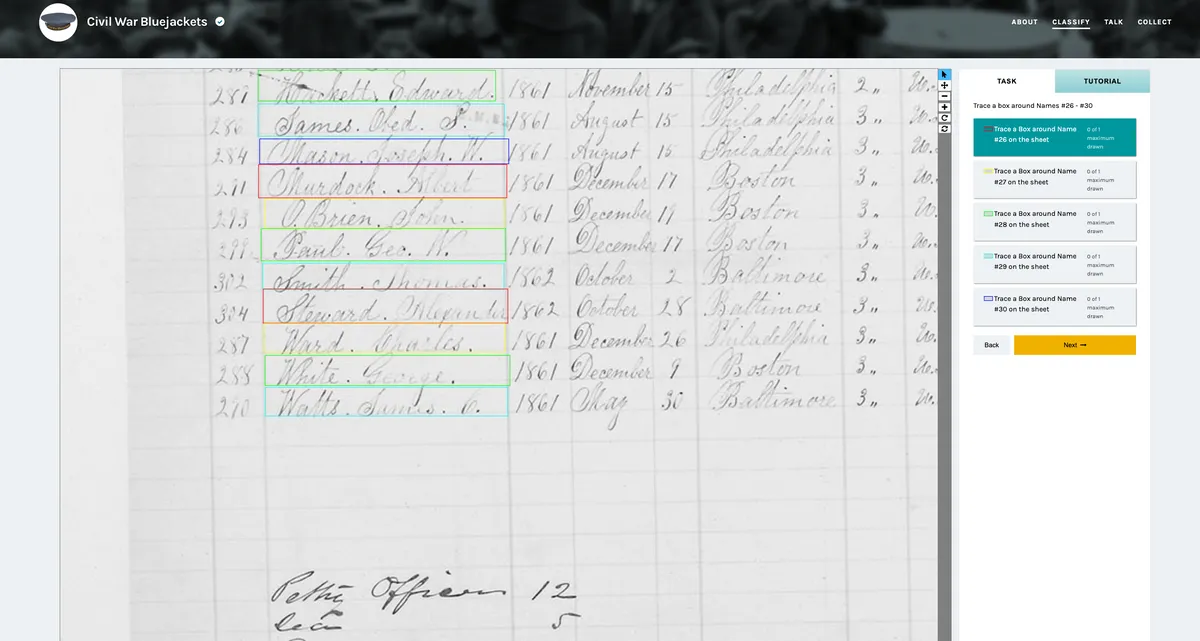
Step 9
There is the option to transcribe 50 records for each sheet. If there are fewer records than 50 on the sheet, just continue to click the 'Next' button until you are finished. You will then be shown a list of the records you have transcribed. Click the yellow 'Next' button to be taken to more records to transcribe.
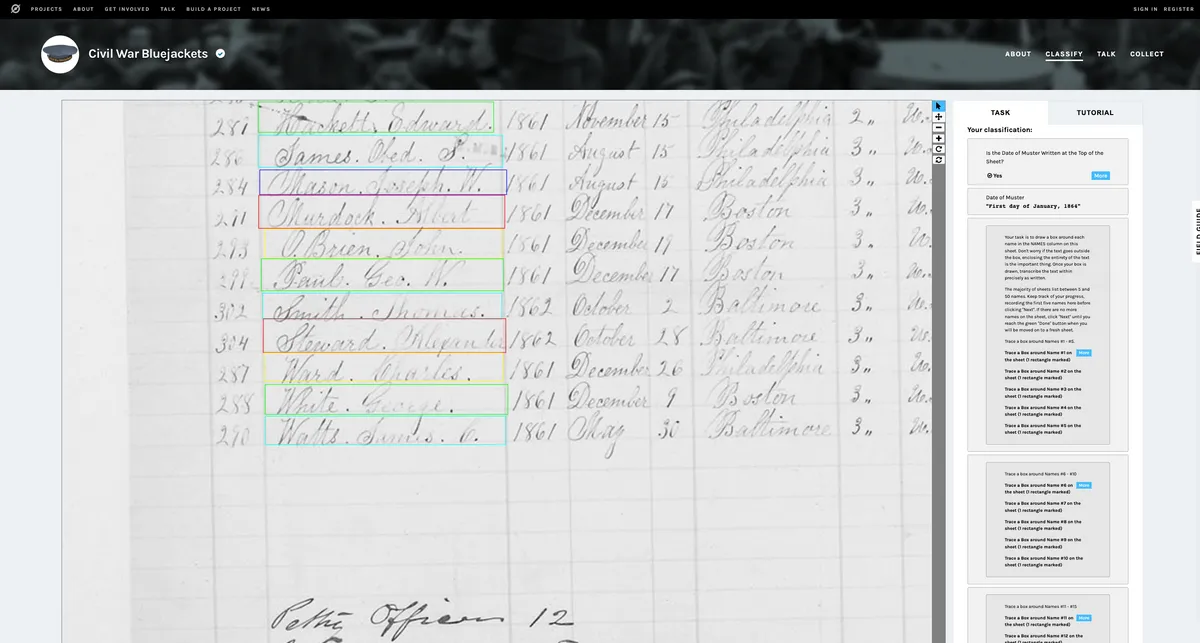
Contact on the day
If you have any problems on Transcription Tuesday on 31 January, please email Damian Shiels at Northumbria University on d.shiels@northumbria.ac.uk.